When you buy through our links, we may earn an affiliate commission.
Choosing a guitar that is suitable for kids can be challenging. You need to consider the design and type of the guitar and ensure that it suits the style they want to play.
The best guitars for kids should be compact so that it’s easy to move between the notes despite having smaller hands and fingers. They should also be versatile so kids can develop their playing without being restricted.
Our #1 recommendation is the Yamaha APXT2, a highly comfortable and lightweight acoustic guitar that can be plugged into an amplifier.
It’s important that kids feel inspired to pick up their guitar and enjoy playing it as much as possible. In this guide, we’ve chosen the best guitars for kids, with acoustic, classical, and electric instruments to suit all abilities and budgets.
Let’s take a look at the options!
Quick Summary of the Best Guitars for Kids
- Yamaha APXT2 Acoustic-electric Guitar (Best Overall)
- Squier Mini Strat Electric Guitar (Best Electric Guitar for Kids)
- Cordoba Cadete Acoustic Guitar (Best Classical Guitar for Kids)
- Yamaha JR1 Acoustic Guitar (Best Budget Kids Guitar)
- Squier Mini Jazzmaster HH Electric Guitar (Best Kids Guitar for Performing)
- Fender FA-15 Acoustic Guitar (Best Travel Guitar for Kids)
Best Guitars for Kids
1. Best Overall – Yamaha APXT2 Acoustic-electric Guitar
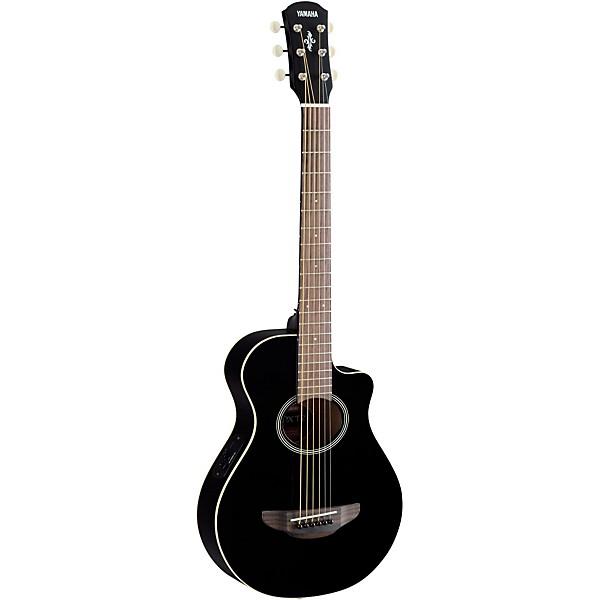
SPECS
- Type: Acoustic-electric
- Neck Profile: Standard
- Scale Length: 22.81”
- Pickups/Electronics: System 68 with ART 1-way Contact Pickup
The Yamaha APXT2 is a smaller reincarnation of the popular APX500 acoustic-electric guitar. Its ¾-sized design makes it an excellent option for younger guitarists of all abilities, whether they’re just starting to learn the basics or they’re already accomplished.
Unlike many compact guitars, the APXT2 doesn’t compromise on tone. High-quality materials, such as the spruce-topped meranti body, ensure a good balance of lows, mids, and treble frequencies so kids can enjoy a full-bodied sound with no weak spots.
Youngsters with small hands will find the 15.75” radius makes it easier to move up and down the 21 frets. Furthermore, rosewood has been used for the fingerboard, which ensures a smooth, responsive feel.
Another thing that makes this Yamaha guitar perfect for kids is its high-quality built-in tuner. This tool will help the guitarist become accustomed to tuning their strings and allow them to quickly rectify any tuning issues that will inevitably occur when they’re practicing.
Even if the young guitarist isn’t quite ready to start performing yet, including the ART-based preamp and System 68 contact pickup will allow them to plug into an amplifier and rock out as soon as they feel ready.
2. Best Electric Guitar for Kids – Squier Mini Strat Electric Guitar
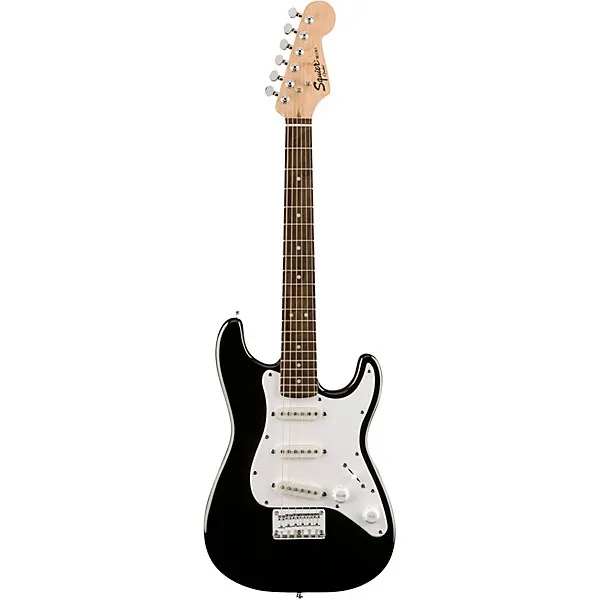
SPECS
- Type: Solidbody Electric
- Neck Profile: C
- Scale Length: 22.75”
- Pickups/Electronics: 3 x Standard Strat Single-coils
When you’re a kid, a guitar's appearance is often equally important as how it sounds or feels. Playing guitar is a great way for kids to stand out and express themselves, and what better way to do this than by owning a mini version of arguably the most iconic electric axe ever made?
The Squier Mini Strat compacts the signature Fender Stratocaster design into a ¾ size version. It’s the ultimate choice for kids who are ready to switch from acoustic guitar to electric guitar or who want to experiment with the broader range of sounds that electric is capable of.
Squier’s design stays true to the blueprint laid out by Fender in the early 1960s, with a trio of single-coil pickups providing the classic, vintage tone. The Mini Strat is very versatile, encouraging kids to experiment with various styles of playing, which is important for their development as guitarists.
The Indian laurel fingerboard, which consists of 20 medium-sized frets, allows young guitarists to play with speed and precision while remaining comfortable in their smaller hands.
Finally, the 5-way blade pickup switch offers a tonal variation that ensures the guitarist never gets bored when playing through an amp!
3. Best Classical Guitar for Kids – Cordoba Cadete Acoustic Guitar

SPECS
- Type: Nylon String Classical Guitar
- Neck Profile: Classical
- Scale Length: 24.2”
- Pickups/Electronics: N/A
Classical guitars, like the Cordoba Cadete, are by far the easiest for a kid to learn the basics on. Combining a ¾ size design with nylon strings makes this instrument a superb option for beginners.
Nylon strings are significantly easier to press down against the frets than steel strings, but there’s often a trade-off regarding dynamics and tonal balance. However, with a Canadian cedar top and mahogany back and sides, Cordoba has created a classical guitar that produces a full-bodied sound.
The fingerboard offers the ideal space for beginners and young players to explore, with 19 effortless and smooth frets. Cordoba has added fan bracing to cope with those inevitable bumps and scrapes that occur when kids play guitar. This also reinforces the top and increases resonance.
With several cool-looking add-ons, such as the gold tuners with pearl buttons, this classical guitar is bound to inspire a kid to push through the formative stages of learning to play.
4. Best Budget Kids Guitar – Yamaha JR1 Acoustic Guitar
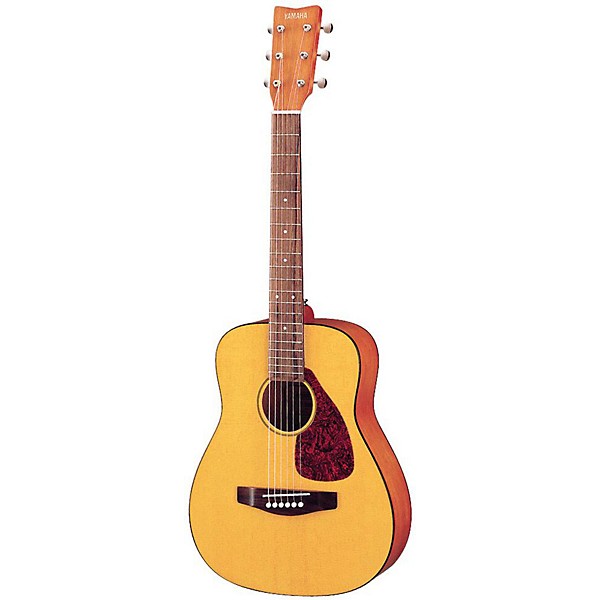
SPECS
- Type: Steel String Acoustic
- Neck Profile: Standard
- Scale Length: 21.25”
- Pickups/Electronics: N/A
Robust and reliable, the Yamaha JR1 is a great instrument for kids at the beginning of their guitar-playing journey. This dreadnought acoustic guitar is suitable for a wide range of musical styles, which is an important quality for a kid’s guitar as it encourages experimentation.
The best acoustic guitars for kids should combine cool aesthetics, a balanced tone, and easy playability. The JR1 checks all the boxes while being one of the most affordable options.
If a young guitarist hasn’t developed the finger strength required to press the strings down firmly for long periods, the smooth feel of the rosewood fingerboard will make this process much easier.
Another reason this acoustic guitar is a great choice for kids is its simple, traditional design. It’s based on one of Yamaha’s most popular acoustic guitar series, the FG, which is synonymous with folk music.
The lack of a cutaway gives it an authentic, vintage style, and its rich, resonant tone makes the learning process more engaging for kids.
5. Best Kids Guitar for Performing – Squier Mini Jazzmaster HH Electric Guitar
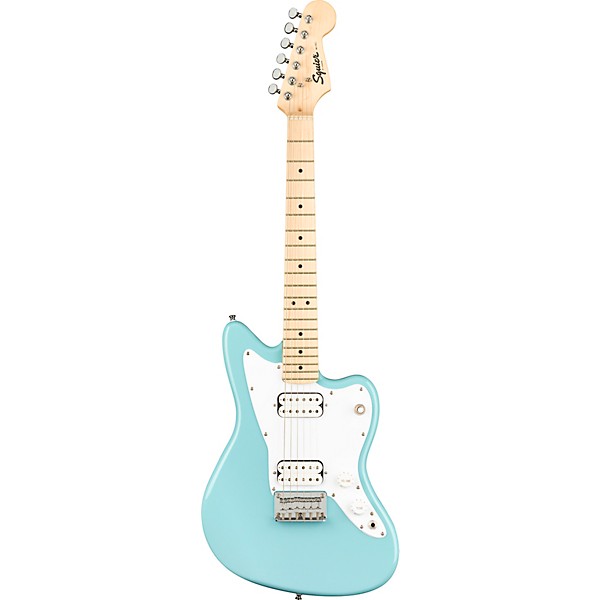
SPECS
- Type: Solidbody Electric
- Neck Profile: C
- Scale Length: 22.75”
- Pickups/Electronics: 2 x Standard Humbuckers
The Mini Jazzmaster is one of the best electric guitars for kids. This compact powerhouse allows younger players to experience the expressive tone and luxurious playability of the popular Fender solidbody without over-straining their hands.
Some “mini” versions of electric guitars simply copy the aesthetics but fail to deliver a similar tone or playing experience. That’s not the case with the Mini Jazzmaster, though. Squier has emulated the full-sized design to a tee in appearance and sound.
A reduce scale size allows kids to navigate the frets with ease. They won’t be put off learning to play barre chords or scales that require stretching, resulting in faster development of their skills.
The slim “C” profile maple neck is great for combining rhythm and lead guitar parts, and the choice of poplar for the body keeps weight to a minimum while preserving the resonance and power of this electric guitar.
Like the full-sized Fender model, the Jassmaster Mini HH includes a pair of creamy-sounding humbuckers that sound awesome through a solid-state or tube amp. It’s ideal for kids who want to play around with the settings on their amp or start incorporating effects into their guitar playing.
6. Best Travel Guitar for Kids – Fender FA-15 Acoustic Guitar
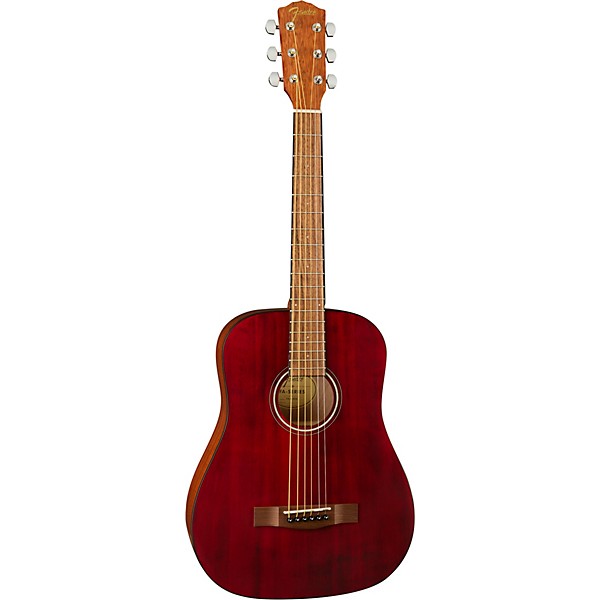
SPECS
- Type: Steel String Acoustic
- Neck Profile: C
- Scale Length: 23.3”
- Pickups/Electronics: N/A
If a kid has heard of any guitar manufacturer before, the chances are it’ll be Fender. The FA-15 allows youngsters to own a guitar made by the legendary American brand without breaking the bank.
The FA-15 is a perfect acoustic guitar for kids for several reasons. It has a fully laminated body, which is more durable than your average beginner guitar. This means it’s highly resistant to being bumped or dropped - two things that often occur with younger guitarists.
The FA-15 has a louder, fuller projection than many other kids' guitars. While this may not be ideal if you live in a small space, it’s ideal for youngsters who aspire to perform in front of other people.
Finger fatigue can deter kids from putting in the hours of practice required to reach their potential, but the walnut fingerboard ensures that this isn’t an issue.
Playing with a classic C-shape acoustic guitar neck will stand a child in good stead if they upgrade to a full-sized guitar in the future.
Best Guitars for Kids Buyer's Guide
In order to choose the best guitar for kids, you need to consider every aspect of the instrument's design.
It's important that young players feel inspired to put in the time and effort required to hone their skills, and this all starts with the guitar they have.
As you can see from the options we've recommended, kids can choose from a variety of guitars. While it's great that there is an abundance of great guitars out there, this can make it difficult to know where to start.
Our buyer's guide will cover all the important aspects of the best guitars for kids, from the components to how they sound and feel. We'll provide detailed breakdowns of the essential qualities so that you can ensure you choose the right electric or acoustic guitar for a young musician.
Things to Look for When Buying a Kids Guitar
1. Size and Weight: The generally smaller size of children’s hands can make it difficult for them to stretch the distances required by a full-sized guitar’s frets.
Also, full-sized guitars are heavy, making them uncomfortable for kids to handle. It’s therefore important to choose an adequately sized guitar for the kid, such as a ¾ sized instrument.
2. Playability: Comfort is highly important for kids when they start playing guitar, as it allows them to learn the basic techniques, chord shapes, and movements without becoming discouraged.
Playability is impacted by things like the action of the strings, the neck profile, and the material used for the strings. A low-action guitar with a thin neck and nylon strings is generally the most playable.
3. Quality and Durability: It's a common misconception that smaller guitars lack the build quality of their larger equivalents.
Look for a guitar that is made from high-quality tonewoods like solid Sitka spruce for the body or a mahogany neck, as this will ensure it can handle the inevitable wear and tear.
4. Dynamics: If you live in a small space, you may not want to hear every note that your child plays on their new guitar
. Classical guitars offer lower volumes while still allowing the kid to play at full velocity. If loudness isn't an issue, then a guitar with a wider dynamic range is worth considering.
Choosing the Right Type of Guitar
Before considering a guitar's various specs and features, you must figure out which type of guitar will best suit the young guitarist's needs. The three options you have to choose from are:
• Classical guitars
• Acoustic guitars
• Electric guitars
Classical guitars have nylon strings and are a great choice for kids who are total beginners. The nylon strings are considerably easier to push down than steel strings, which can help with the often painful and uncomfortable process of learning to form chord shapes.
These guitars have wide necks, which ensures that there is more space between the six strings. This makes it easier for the beginner to focus on strumming and pressing on the right string without muddying up the sound.
Classical guitars are quieter than acoustic guitars and aren't as versatile. Acoustic guitars have steel strings that offer increased projected and a fuller tone but are more strenuous on the fingertips.
Learning to play on an acoustic guitar is great for building finger strength quickly, but there will be a period of discomfort initially while the young player's fingertips get used to it.
Mini electric guitars require additional equipment, such as an amplifier and guitar cable, in order to be played properly. They're by far the most versatile type of guitar for kids, as they can be used with effects pedals to create an endless range of sounds.
They're easier on the fingers than acoustic guitars but require more accuracy to play the right notes. They're also the best option for playing solos or styles like hard rock and metal guitar.
Scale Length & Fret Size
Once you've decided on the specific type of guitar, the dimensions are next to look for. Two of the most important attributes of a guitar for kids are the scale and fret size, as these directly impact the playability and comfort of the instrument.
The scale of a guitar is essentially the distance between the point where the strings first come into contact with the guitar by the nut to the saddle, which is situated on the bridge where the strings end.
A guitar with a smaller scale, like the Yamaha JR1, has a lower string tension. The frets are also closer together, and this results in less stretching being required by the kid's fingers to form the correct shapes for chords or to play scales.
It's advised not to choose a guitar that exceeds a 24.5-inch length of scale for kids, and those with smaller hands should look for one that is within the range of 21-23 inches.
The size of the frets is another important thing to consider when purchasing a compact guitar for kids. Larger or medium-sized frets can actually be beneficial for youngsters and are often installed on short-scale guitars as they increase the room for error when pressing on the string to play a note.
Pickups and Electronics
Some of the guitars we've recommended, such as the Cordoba Cadete classical guitar, don't come with onboard electronics. This isn't necessarily bad, as amplification may not be necessary when a kid is starting to learn the guitar.
However, some young players may want to have the option to plug in their instrument and rock out from time to time. If this is the case, you can choose either an electric guitar or an acoustic-electric guitar, which offers the best of both worlds.
Acoustic-electric guitars come with an onboard preamp and pickup system that allows you to plug them into an amp to make the output louder. If there's a good chance that the young guitarist will want to perform live in the future, investing in an instrument with this capability, like the Yamaha APXT2, is advisable.
Onboard tuners are also included in most electro-acoustic guitars, and this can be very convenient for kids. Furthermore, choosing an electric guitar with single-coil or humbucking pickups is a great way to encourage the youngster to learn how to create different sounds.
Guitar Aesthetics
The technical aspects of a great guitar for kids are undeniably important, but the visual aspects also shouldn't be overlooked. Young children, in particular, are likely to see aesthetics as equally important as sound or playing comfort.
Electric guitars like the Squier Mini Strat or Mini Jazzmaster allow young guitarists to experience the stunning designs of guitars that resemble those played by some of the coolest, most iconic musicians in history.
It ultimately comes down to the personal preference of the kid, but it's a good idea to identify the color schemes, designs, and hardware that they like the look of. If they love how the instrument looks, they're more likely to want to pick it up and play it regularly.
One of the great things about guitars is that so many different designs are available. Whether the kid prefers a simple acoustic guitar or an eccentric electric guitar, they can find one with a design that takes their fancy.
Frequently Asked Questions (FAQs)
What size guitar should I get for my child?
In order to choose the right guitar for a child, you'll need to assess a few things. Firstly, if their hands are smaller than the average adult, it's a good idea to choose a 3/4 size, short-scale guitar as this will allow them to reach the notes more easily.
As a general rule of thumb, a kid from 8 years old onwards should be able to use a 3/4 size guitar. Once they get into their teenage years, they may be able to handle the weight and dimensions of a full-size guitar, but it's important not to rush into this.
Some guitars may have larger bodies, but the neck and the fingerboard could be smaller. It's, therefore, important to check all of the dimensions before making the decision of which guitar to buy.
Which guitar type is best for a kid who is a total beginner?
If a kid has never played the guitar before or has very limited experience, it's advisable to go for a classical, nylon-stringed instrument like the Cordoba Cadet. This type of guitar is by far the least strenuous on the hands and fingers.
The initial period of learning guitar can be quite uncomfortable, particularly on the soft fingertips of a kid who has never played before. Some guitarists become discouraged by this period, but if they stick with it, their fingers become harder and used to the pressure.
Choosing a nylon-stringed acoustic guitar for a beginner will allow them to focus on learning the basics of strumming, picking, and pressing down on the frets without having to put up with pain in the fingertips.
Does a kid need any other equipment to learn guitar?
Whether more equipment is required for a kid to learn guitar depends on the type of instrument you choose. Acoustic guitars and classical guitars can be played unplugged. All you'll need is a guitar strap to support the weight of the instrument, and you're good to go.
Electric guitars will need an amplifier of some sort and a guitar cable in order to be played out loud. Practice amps are inexpensive, and cables don't cost much.
You may need to purchase spare strings and a tuner if the guitar doesn't have one built in. Other than that, not much is required for a kid to learn the guitar!
Closing Thoughts
Now that you've read our guide to the best guitars for kids, you should have a good idea of which instrument is the right choice.
Our top recommendation is the Yamaha APXT2 acoustic-electric guitar, with its lightweight design, full-bodied tone, and ability to be played acoustically or plugged into an amplifier.
If you're looking for the easiest guitar for a kid to play, the Cordoba Cadete, with its soft nylon strings, is an excellent option.
Whichever of these instruments you choose, we're confident they're highly suitable for kids and will help them to reach their maximum potential as guitarists!
